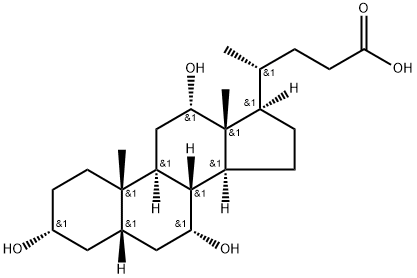LITHOCHOLIC ACID
Synonym(s):3α-Hydroxy-5β-cholan-24-oic acid;3α-Hydroxy-5β-cholanic acid;5β-Cholan-24-oic acid-3α-ol
- CAS NO.:434-13-9
- Empirical Formula: C24H40O3
- Molecular Weight: 376.57
- MDL number: MFCD00003682
- EINECS: 207-099-1
- SAFETY DATA SHEET (SDS)
- Update Date: 2025-12-22 14:18:24

What is LITHOCHOLIC ACID?
Chemical properties
white to off-white powder
The Uses of LITHOCHOLIC ACID
Lithocholic acid has been used in a study to assess cholestasis and its action on several organs and tissues in rats. It has also been used in a study to investigate the regulation of hepatic phospholipid and bile acid homeostasis through SMAD3 activation by TGFβ.
The Uses of LITHOCHOLIC ACID
A cholic acid derivative as TGR5 modulator. Found in ox bile, human bile, rabbit bile, and in ox and pig gallstones.
The Uses of LITHOCHOLIC ACID
LD50(mouse) 3900 mg/kg po
The Uses of LITHOCHOLIC ACID
Cholagogue;Anticholelithogenic
What are the applications of Application
Lithocholic acid is a bile acid
Definition
ChEBI: A monohydroxy-5beta-cholanic acid with a alpha-hydroxy substituent at position 3. It is a bile acid obtained from chenodeoxycholic acid by bacterial action.
General Description
Hexagonal leaflets (from alcohols) or prisms (from acetic acid) or white powder.
Air & Water Reactions
Insoluble in water.
Health Hazard
ACUTE/CHRONIC HAZARDS: When heated to decomposition LITHOCHOLIC ACID emits acrid smoke and fumes.
Fire Hazard
Flash point data for LITHOCHOLIC ACID are not available. LITHOCHOLIC ACID is probably combustible.
Biological Activity
lithocholic acid (lca) is a toxic secondary bile acid, causing intrahepatic cholestasis, which has tumor-promoting activity.
in vitro
among 17 kinds of bile acids with respect to inhibition of mammalian dna polymerases, only lca and its derivatives inhibited dna polymerases, while other bile acids did not show inhibitory effect [1].
in vivo
administration of lca and its conjugates to rodents causes intrahepatic cholestasis, which is a pathogenic state characterized by decreased bile flow and the accumulation of bile constituents in the liver and blood [2].
Purification Methods
Lithocholic acid can be purified by conversion to the rather insoluble Na or K salt by addition of the equivalent amount of aqueous NaOH or KOH, filtering off the alkali salt, washing it with ice cold H2O, dissolving it in the least volume of boiling H2O, acidifying with the dilute HCl (slight excess), filtering off the acid, washing with cold H2O and drying it thoroughly in a vacuum. Recrystallise it from Me2CO, EtOH or acetic acid. The methyl ester crystallises from MeOH, with 0.5 mol of MeOH, and has m 92-93o, [] D 25 +34o (MeOH). It has also been purified by recrystallisation from pet ether (b 40-60o) and, after chromatography on Al2O3 in pet ether, gave a labile form m 92-93o which is transformed to the stable form m 125-126o after standing for 2days in a vacuum desiccator. [Hoelm & Mason J Am Chem Soc 62 569 1940, Sarel & Yanuka J Org Chem 24 2018 1959, Beilstein 10 IV 785.]
References
[1] ogawa a, murate t, suzuki m, nimura y, yoshida s. lithocholic acid, a putative tumor promoter, inhibits mammalian dna polymerase beta. jpn j cancer res. 1998 nov;89(11):1154-9.
[2] staudinger jl, goodwin b, jones sa, hawkins-brown d, mackenzie ki, latour a, liu y, klaassen cd, brown kk, reinhard j, willson tm, koller bh, kliewer sa. the nuclear receptor pxr is a lithocholic acid sensor that protects against liver toxicity. proc natl acad sci u s a. 2001 mar 13;98(6):3369-74.
Properties of LITHOCHOLIC ACID
| Melting point: | 183-188 °C (lit.) |
| Boiling point: | 445.09°C (rough estimate) |
| alpha | D20 +33.7° (c = 1.5 in abs ethanol); D19 +23.3° (Wieland); D20 +32.1° (Fischer) |
| Density | 1.0454 (rough estimate) |
| refractive index | 35.5 ° (C=1, EtOH) |
| Flash point: | 9℃ |
| storage temp. | room temp |
| solubility | Chloroform (Slightly), Dichloromethane (Slightly, Heated), DMSO (Slightly, Heate |
| pka | 4.76±0.10(Predicted) |
| form | Powder |
| color | White to off-white |
| Water Solubility | 18.83ug/L(25 ºC) |
| Merck | 5545 |
| BRN | 3217757 |
| CAS DataBase Reference | 434-13-9(CAS DataBase Reference) |
| EPA Substance Registry System | Lithocholic acid (434-13-9) |
Safety information for LITHOCHOLIC ACID
| Signal word | Danger |
| Pictogram(s) |
 Flame Flammables GHS02  Skull and Crossbones Acute Toxicity GHS06  Health Hazard GHS08 |
| GHS Hazard Statements |
H225:Flammable liquids H370:Specific target organ toxicity, single exposure |
| Precautionary Statement Codes |
P210:Keep away from heat/sparks/open flames/hot surfaces. — No smoking. P260:Do not breathe dust/fume/gas/mist/vapours/spray. P280:Wear protective gloves/protective clothing/eye protection/face protection. P403+P233:Store in a well-ventilated place. Keep container tightly closed. |
Computed Descriptors for LITHOCHOLIC ACID
| InChIKey | SMEROWZSTRWXGI-HVATVPOCSA-N |
LITHOCHOLIC ACID manufacturer
New Products
4,4-Difluoropiperidine hydrochloride tert-butyl 9-methoxy-3-azaspiro[5.5]undecane-3-carboxylate Indole Methyl Resin N-Isopropylurea N,N-Dicyclohexylcarbodiimide(DCC) MELDRUMS ACID 5-METHYLISOXAZOLE-4-CARBOXYLIC ACID Magnessium Bis glycinate Zinc ascorbate 1-bromo-2-butyne 2-acetamidophenol 9(10H)-anthracenone Erythrosin B, 4-Piperidinopiperidine 2-((4-morpholinophenylamino) (methylthio) methylene) malononitrile 2,4-dihydroxybenzaldehyde 3-(4-morpholinophenylamino)-5-amino-1H-pyrazole-4-carbonitrile Methyl 2-methylquinoline-6-carboxylate 2,6-dichloro-4-nitropyridine 4-Bromo-2-chlorobenzonitrile 2-(benzylamino)acetic acid hydrochloride 4-(tert-Butoxycarbonylamino)but- 2-ynoic acid 3,4-dihydro-2H-benzo[b][1,4]dioxepine 1-Phenyl-1-cycloprppanecarboxylicacidRelated products of tetrahydrofuran



![(2S)-2-[[[(1,1-Dimethylethyl)diphenylsilyl]oxy]methyl]-1,3-oxathiolan-5-ol 5-Acetate](https://img.chemicalbook.in/CAS/20180601/GIF/202532-88-5.gif)




You may like
-
 434-13-9 Lithocholic Acid 98%View Details
434-13-9 Lithocholic Acid 98%View Details
434-13-9 -
 Lithocholic Acid CAS 434-13-9View Details
Lithocholic Acid CAS 434-13-9View Details
434-13-9 -
 Lithocholic acid 96% CAS 434-13-9View Details
Lithocholic acid 96% CAS 434-13-9View Details
434-13-9 -
 Lithocholic acid 98.00% CAS 434-13-9View Details
Lithocholic acid 98.00% CAS 434-13-9View Details
434-13-9 -
 Lithocholic acid, 95%+ CAS 434-13-9View Details
Lithocholic acid, 95%+ CAS 434-13-9View Details
434-13-9 -
 Lithocholic acid CAS 434-13-9View Details
Lithocholic acid CAS 434-13-9View Details
434-13-9 -
 99% Lithocholic Acid (working standard), Analytical GradeView Details
99% Lithocholic Acid (working standard), Analytical GradeView Details
434-13-9 -
 Lithocholic AcidView Details
Lithocholic AcidView Details
434-13-9
